In the world of sports, it's no secret that the performance of managers—or head coaches—is evaluated based on a club’s overall sporting results, with the ultimate responsibility frequently falling on one person’s shoulders. However, the number of coaching changes of the clubs currently playing in the “Big Five” football leagues has reached new heights this season. With a total of 170 head coaches employed for at least one match, clubs on average have worked with 1.73 managers during the season, up 26% compared to last year. There is no doubt that the pressure to win is higher than ever before, making it a significant challenge to build long-term projects.
.png)

Over the period of the last five seasons, the numbers are even more staggering: a total of 320 different head coaches (including temporary / interim roles) were employed by the 98 analysed “Big Five” clubs, with the total count rising to 455 if we count the employment of a coach by multiple clubs separately. Looking at the breakdown by league, there are no significant differences between the five analysed leagues over the past five seasons – Serie A and Bundesliga teams have both employed 96 managers in total, followed by La Liga with 93, and the Premier League with 89. The “most stable” one was the French Ligue 1 where 81 managers had a mandate to turn their club’s fortune over the period in question.
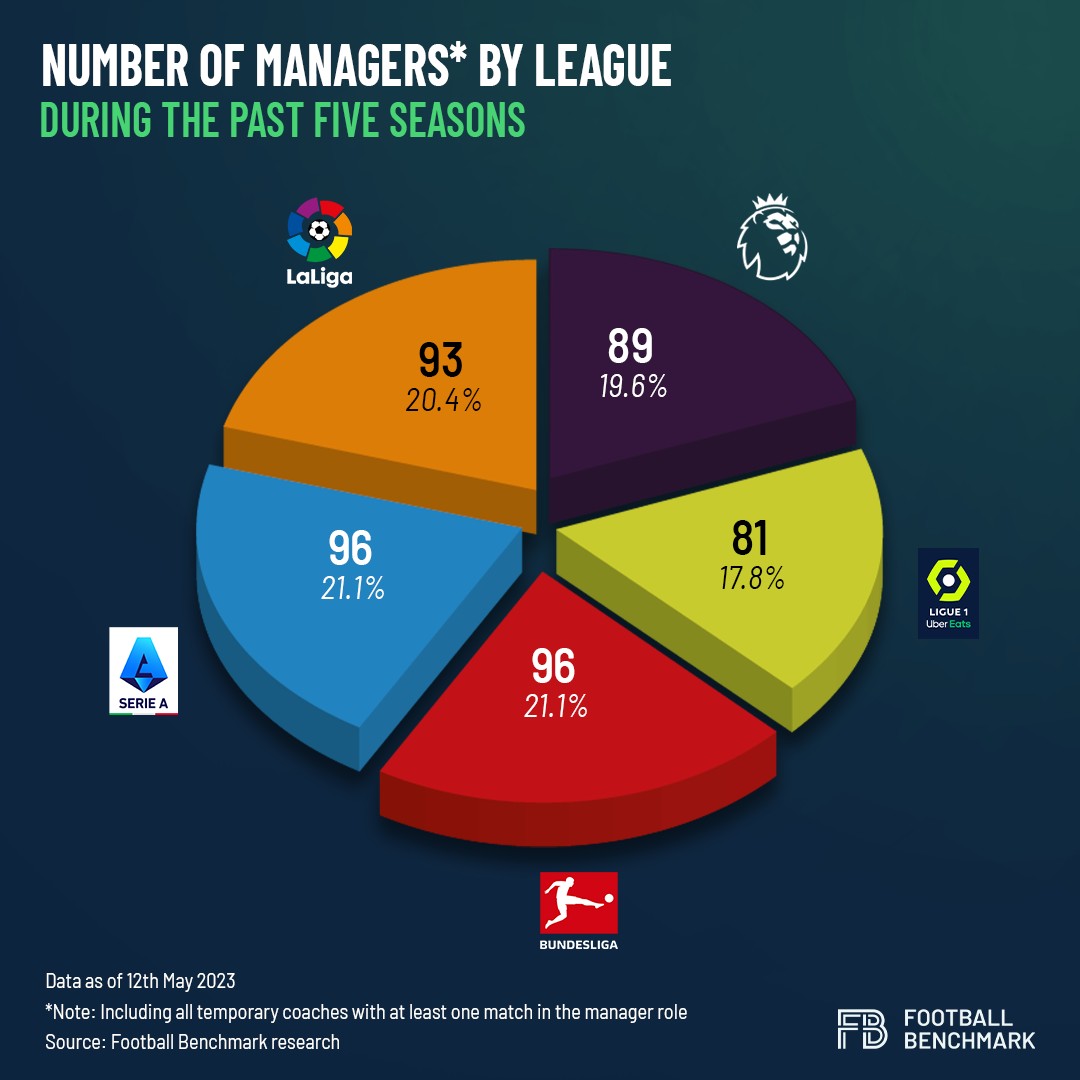
This season, the Premier League set a new record for managers employed, with a total of 42. While almost a quarter of them have been temporary / caretaker solutions, the remaining 33 permanent ones are also a big jump from last season’s comparable figure of 27. Moreover, 11 clubs have changed their head coach during the current season, four more than in any of the seasons of the last 5-year period.
The nature of the dismissals in the English top division is similarly interesting as most of the fired head coaches had long-term contracts, with clubs taking a financial hit rather than exercising patience. A prime example is Graham Potter, who signed a contract until 2026/27 back in September, but was sacked after only 31 matches in charge. Jesse March and Brendan Rodgers had contracts until 2025, while several other dismissed managers were originally tasked to lead their teams until at least the summer of 2024.
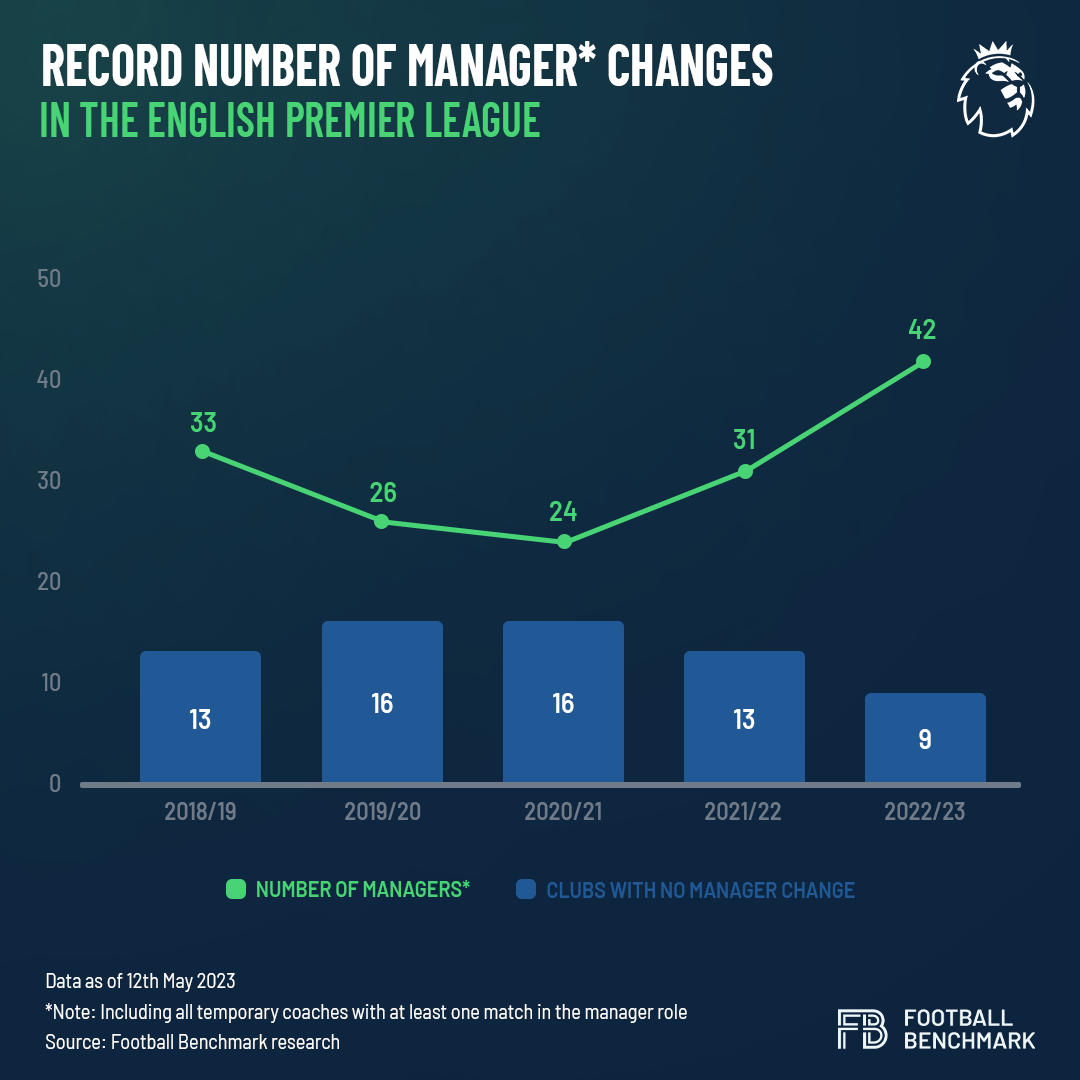
Another phenomenon is to change the head coach more than one time over the season – outside of Chelsea FC, five other “Big Five” clubs have had three coaches during the season that can be considered permanent hires, with the total growing to 26 clubs if we include temporary roles. From the clubs’ perspective, the lack of results can explain the changes, while from the coaches’ point of view, frequent firings can make it difficult for them to establish themselves and their style of play with a team. The level of job security can also impact the attractiveness of certain clubs, as coaches could be more hesitant to take on a job with a team that has a history of firing coaches frequently.
A prime example of the ineffectiveness of such frequent changes are Elche CF, as the club’s fans have seen a total of six different coaches managing at least one match, including three with at least 50 days in charge. The results have remained the same though, as the club is already guaranteed a last-place finish with four matches left in the season. The case has been similar for Southampton FC and Leeds United FC, both struggling to create a “new manager bounce” after multiple changes.
The sacking of Julian Nagelsmann by FC Bayern München also serves as a striking example of the high level of pressure at the very top. Despite still being in contention for the UEFA Champions League and domestic cup, as well as sitting in the 2nd position in the league, the club’s board made the decision to dismiss Nagelsmann in March, citing their belief that he was not the right person for the job. While every situation is unique and the expectations are different at such a big club, the results since the change tell a cautionary tale of expectations for any new manager, with the club now eliminated from both the Champions League and the DFB Pokal, while leading the league only by one point with two rounds to go.
The financial implications of a firing shouldn’t be forgotten either, as clubs may need to pay fees to multiple coaches' simultaneously, adding further challenges, especially in case of smaller budgets. On the one hand, keeping an underperforming coach in charge can be detrimental to a team's fortunes on the field and its reputation off it. Sacking a coach can be an expensive proposition, especially if they are on a long-term contract with a high salary. On the high end of the market, Jose Mourinho is estimated to have received more than EUR 100 million in his career just from being paid off after dismissals. While this is an extreme example, the salaries of football managers – just like the players’– are likely to rise further in the coming years, especially for those who are working for the biggest and most successful clubs.
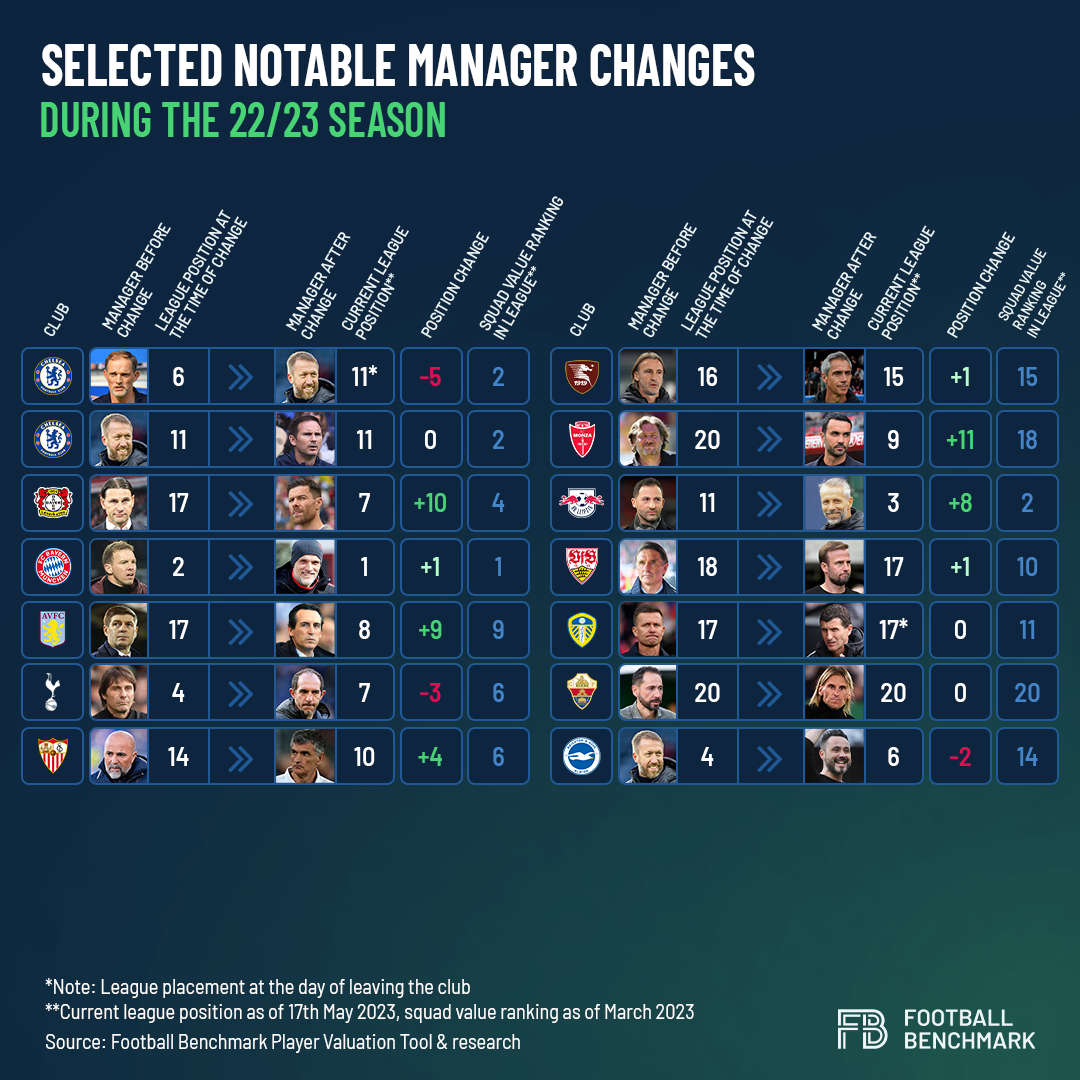
However, it's not all doom and gloom, with plenty of examples of the beneficial nature of a well-timed coaching change during the season. Xabi Alonso took charge of Bayer 04 Leverkusen when they were 17th in the league in October, and he has helped them climb to 6th place in the Bundesliga. The team has also reached the semi-finals of the UEFA Europa League, doing so while not having signed any new players during the January transfer window. Similarly, Roberto De Zerbi has been a revelation at Brighton, with not only fans, but also colleagues like Pep Guardiola acknowledging the Italian’s tactical prowess. Brighton is now fighting for a spot in European club competitions for next season.
Paulo Sousa also stepped in at US Salernitana 1919 in a difficult situation, and despite the club's relatively small squad market value of EUR 103 million, he managed to steer the team away from relegation. Unai Emery took over Aston Villa when they were 17th in the league, and he completely revived the club even to compete for European participation. He achieved this feat while using a squad built by different managers, reaching an extremely high points per game ratio of 1.8.
Over the past five seasons, only nine current “Big Five” clubs have kept faith in one manager throughout, with Diego Simeone being the longest tenured coach in the “Big Five” leagues. Similarly to him, Christian Streich has been managing SC Freiburg since 2011, followed by Olivier Pantaloni of AC Ajaccio. The average tenure of the 98 current “Big Five” club coaches is 618 days, with only 17 managers in charge for more than 1,000 days (as of 12 May 2023).
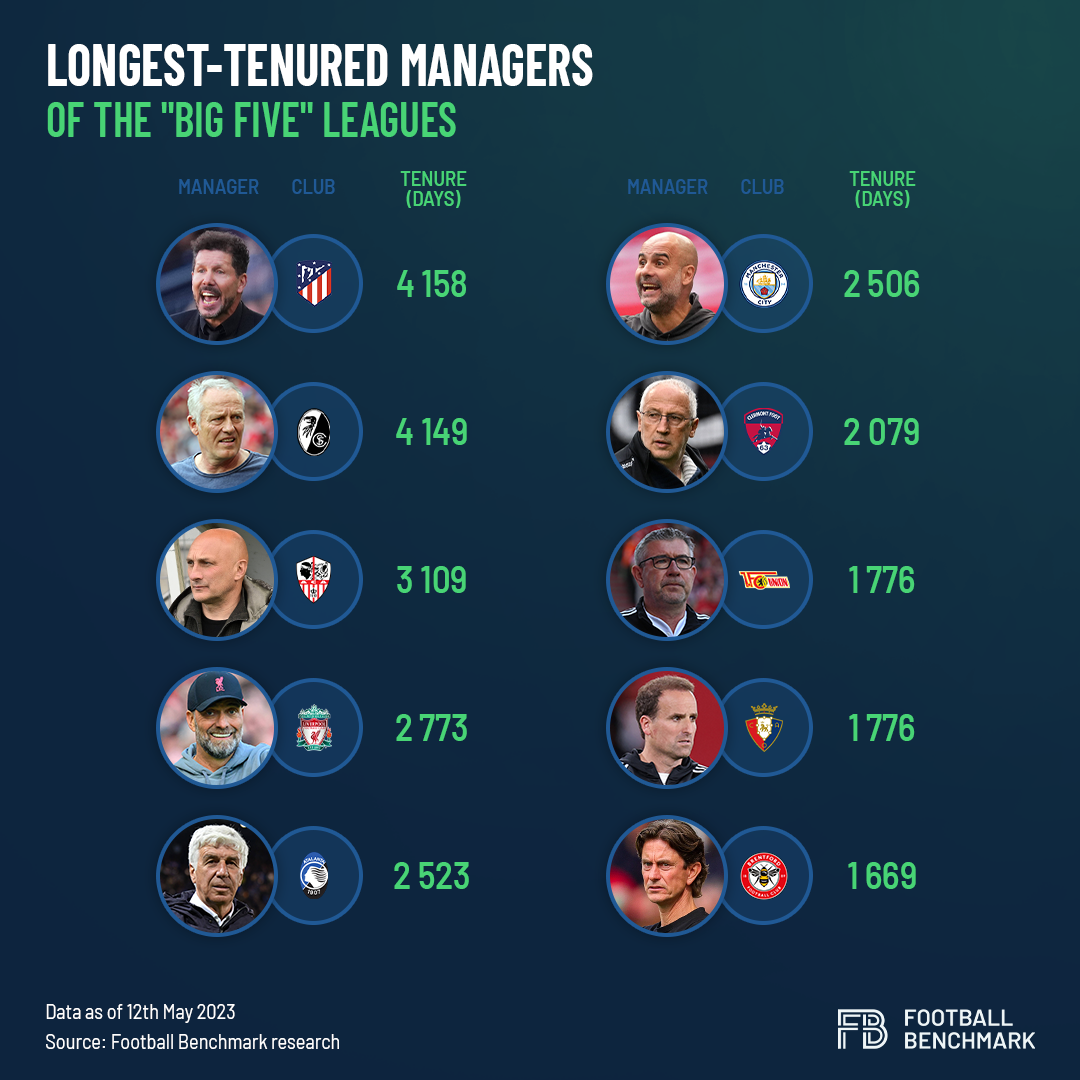
At the other end of the scale, 11 clubs have employed at least eight managers during the past 5 years (considering all managers who have managed at least one game), with FC Schalke 04 reaching a total of 11 managers – more than two per year on average. If we only consider managers who have spent at least 50 days in post, Schalke are joined at the top by Hertha BSC and Empoli FC with all three clubs employing 9 permanent managers during the past five seasons.
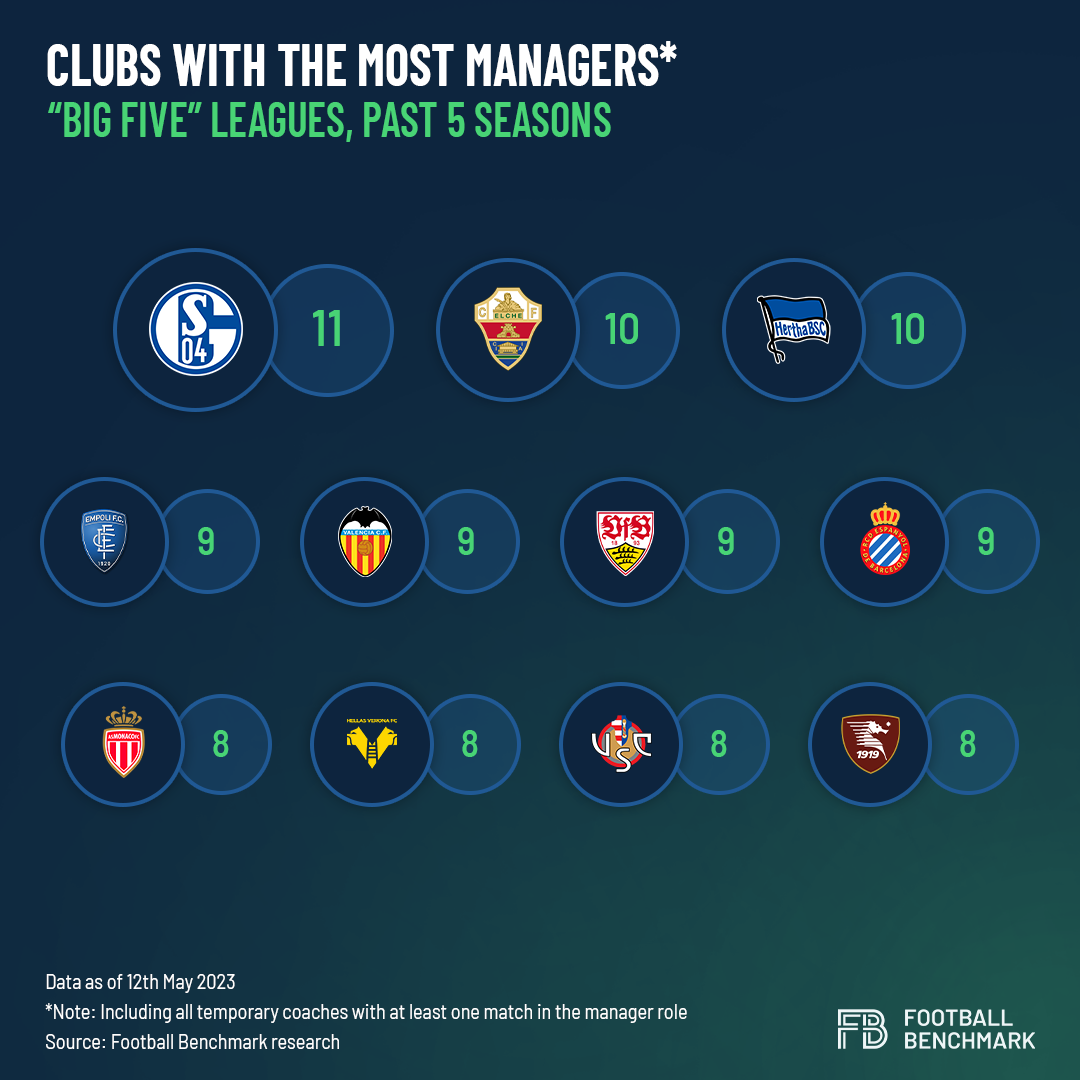
This season, we have also seen the rise of interim and caretaker managers, with clubs firing coaches even before having a replacement in mind. We have identified a total of 36 coaches who have only been hired temporarily, with 15 of them getting jobs in the Premier League. It is possible that the prominence and importance of these caretakers could become the new norm in the coming years.
Overall, while it may seem like firing coaches is a quick fix for underperforming clubs, it is also important for them to consider the long-term implications of this decision. Frequent coaching changes can lead to instability, both on and off the field, and can make it difficult for teams to establish a consistent style of play and culture. It is important for teams to carefully evaluate the situation before making any decisions, and to consider alternative solutions before resorting to firing a coach. Ultimately, getting this decision right will go a long way, not only in terms of sporting performance, but also off the pitch, including financial results and brand development.


